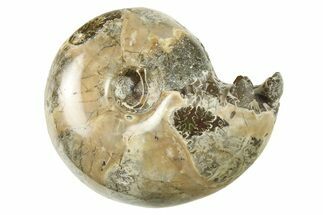This Specimen has been sold.
26" Wide Polished Ammonite & Nautilus Cluster - Madagascar
Here is a large polished ammonite cluster still embedded in the rock in which they were found. It is 26" x 11" x 8". There are three main ammonites the largest measuring 9.6" wide. On the end ammonites, the polishing has exposed the intricate suture pattern of the inner shell. Many other fossils including clams, gastropods and a nautilus can also be seen in the rock.
The ammonites are Cretaceous (Albian Stage) in age or approximately 110 million years old and are quarried in the Mahajanga Province of Madagascar.
The ammonites are Cretaceous (Albian Stage) in age or approximately 110 million years old and are quarried in the Mahajanga Province of Madagascar.
About Ammonites
Ammonites were ancient marine cephalopods, similar to today's squids and octopuses, but with a defining feature: their distinctive, tightly coiled spiral shells. These shells, resembling those of modern nautiluses, served as both a protective home and a buoyancy aid, allowing ammonites to navigate the prehistoric seas with ease. First emerging around 240 million years ago in the Triassic Period, ammonites thrived for over 175 million years, adapting through numerous forms and sizes. As predatory creatures, they likely fed on smaller marine organisms, using their tentacles to capture prey. However, their long reign came to an end 65 million years ago at the close of the Cretaceous, coinciding with the mass extinction event that also eliminated the dinosaurs.
Ammonites were ancient marine cephalopods, similar to today's squids and octopuses, but with a defining feature: their distinctive, tightly coiled spiral shells. These shells, resembling those of modern nautiluses, served as both a protective home and a buoyancy aid, allowing ammonites to navigate the prehistoric seas with ease. First emerging around 240 million years ago in the Triassic Period, ammonites thrived for over 175 million years, adapting through numerous forms and sizes. As predatory creatures, they likely fed on smaller marine organisms, using their tentacles to capture prey. However, their long reign came to an end 65 million years ago at the close of the Cretaceous, coinciding with the mass extinction event that also eliminated the dinosaurs.
SPECIES
Unidentified
LOCATION
Ambatolafia, Mahajanga Province, Madagascar
SIZE
26" Wide, 11" Tall, 8" Deep
CATEGORY
SUB CATEGORY
ITEM
#109235
We guarantee the authenticity of all of our specimens.
 Reviews
Reviews

















